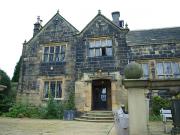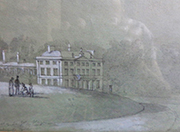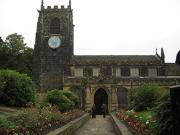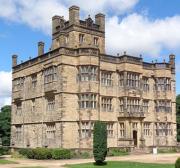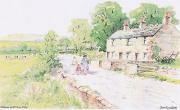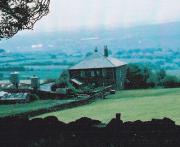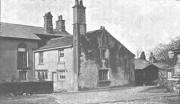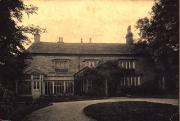Kay Homes
Welcome to our picture gallery. Over the years we have accumulated photos of various buildings and localities with Kay connections. We’d like to share some of them here, with a brief outline of the history and Kay link. The information shown here has been drawn from a large number of sources and it is not feasible to give individual references, or make direct acknowledgements for every one of them. We do however give sincere thanks to everyone who has contributed, wittingly or unwittingly. And of course we welcome more contributions to our family photo album.
Each of the articles on this page can be opened out to its full length by clicking on the link at the end of the paragraph. You can click on any of the pictures to see an enlarged version; let the show run or use the arrows to navigate through the pictures if you’re in a hurry. The video button at the top of the show can be used to pause it at any time.
Woodsome
John Kay was not the first Yorkshire Kay (there are records of Kays in the county from the beginning of the thirteenth century), but he was the founder of a line that was to last for centuries and still continues. Woodsome is in Almondbury, about two miles south east of the centre of Huddersfield, and in 1375 John was granted the manors of Slaithwaite and Woodsome cum Farnley Tyas by Dame Alice Fyncheden or Finchden. More information about this and John’s origins can be found on our site in the article John Kay of Salfordshire and Farnley Tyas by Dr George Redmonds.
(Show full text)John Kay was not the first Yorkshire Kay (there are records of Kays in the county from the beginning of the thirteenth century), but he was the founder of a line that was to last for centuries and still continues. Woodsome is in Almondbury, about two miles south east of the centre of Huddersfield, and in 1375 John was granted the manors of Slaithwaite and Woodsome cum Farnley Tyas by Dame Alice Fyncheden or Finchden. More information about this and John’s origins can be found on our site in the article John Kay of Salfordshire and Farnley Tyas by Dr George Redmonds.
In recognition of these origins, the Kays of Woodsome quartered their arms with those of Fyncheden; the arms were formally registered in 1564, and the pedigree that accompanied that registration is a good record of the early generations of the family. Fifth in line of descent from the first John was Arthur Kay, who put in train the work that made the house we know now. The names of Arthur and his wife Beatrix can still be seen, carved over the fireplace. Arthur died in 1582; some sources say he had retired to his Lancashire properties “for quietness”, but this is questionable given that he was buried in the church of All Hallows in Almondbury.
Arthur’s son John had two wooden panels hung on either side of the fireplace in the Great Hall at Woodsome, suspended from iron cranes. These were paintings of himself and his wife Dorothy; John is pictured in a girdled gown, the family tree of his progeny springing from his loins “the fruit of the house of Woodsome”, and at the back are sixty six shields of gentle houses “the divers coats of sundry friends” that were of kin to the Kay family at this early date. These panels are now in Huddersfield.
The presence or absence of the trailing ‘e’ in our name has long been a matter of debate and some rivalry in our ranks, and it is usual to assume that Kaye denotes a Yorkshire origin. Arthur quite definitely spelt his name ‘Kay’, as did the original John. But the stained glass window in the Kaye Chapel in All Hallows, dating from the fifteenth century, uses the form ‘Kaye’. Spelling was erratic at the time, so we’ll stick with the accepted spelling of ‘Kaye’ for the family.
Fourth in descent from this Arthur Kay was Sir John Kaye of Woodsome; a supporter of the King in the Civil War, he was created a baronet by King Charles I in 1641-2. His eldest son John succeeded him at Woodsome as second baronet, sat as a county member in four Parliaments and died in 1706. He married Ann daughter of William Lister and was succeeded by his eldest son Arthur, who died in 1726 and was the last Kaye of Woodsome. Arthur left an only daughter and heiress, Elizabeth, who married George Legge, Viscount Lewisham and eldest son of the 1st Earl of Dartmouth, thus taking the Woodsome estate into that family.
(Return to the summary)Denby Grange
But that is not the end of the story. The Woodsome line still continues with the Lister-Kayes who lived at Denby Grange until 1952. The picture shown here, executed in chalk pastels, was found in an antique shop in Bloomsbury and was the trigger for the whole concept of this page!
(Show full text)But that is not the end of the story. The Woodsome line still continues with the Lister-Kayes who lived at Denby Grange until 1952. The picture shown here, executed in chalk pastels, was found in an antique shop in Bloomsbury and was the trigger for the whole concept of this page!
The manor of Denby Grange had been held by the Woodsome Kayes for several generations, and after the death of the last Sir Arthur Kaye of Woodsome, it was inherited by John, the son of Arthur’s brother George. John also inherited the title, becoming the 4th baronet. Another brother Thomas had inherited the estates of his cousin Christopher Lister, conditional upon his assuming the surname of Lister. Dying unmarried, Thomas left his property to his elder brother Arthur and his male issue, and failing such to his other brother George in succession. John therefore inherited the Lister estates as well; following the conditions of the will, the family assumed the additional name of Lister. That line has endured to this day.
It was Sir John who built the house shown in these pictures. His portrait can be seen on our home page. The house was demolished in 1952 by the newly-formed National Coal board.
(Return to the summary)All Hallows, Almondbury
Dating from the late 12th century, the church of All Hallows has witnessed the passage through life of many Kayes. Almondbury is notable as the centre of one of those areas where there has always been an above-average concentration of people bearing our name.
(Show full text)Dating from the late 12th century, the church of All Hallows has witnessed the passage through life of many Kayes. Almondbury is notable as the centre of one of those areas where there has always been an above-average concentration of people bearing our name.
The church itself dates from the second half of the fifteenth century and bears the stamp of the Woodsome Kayes. The Kaye chapel is an integral part of the fabric, and dates from the same period – the age of the stained glass window in the chapel attests to that, showing members of the family dressed in the costume of the time. The chapel holds the graves of many of the family, from the sixteenth century Arthur to the last Sir Arthur of Woodsome.
(Return to the summary)Gawthorpe Hall
Completed in the early 1600s, Gawthorpe Hall in Padiham was designed by Robert Smythson whose earlier commissions included Hardwick Hall in Derbyshire. It was built around an earlier ‘pele’ tower believed to date from the 14th century. The only significant exterior change to the Elizabethan building has been the addition of an extra storey and parapet to the central tower and the enlargement of the front entrance by the architect Charles Barry in the 19th century. The house is now owned by the National Trust and administered by the Lancashire County Council Museum Service to whom we are indebted for many of the pictures shown here and for their assistance. For further information, see www.lancashire.gov.uk/museums and www.nationaltrust.org.uk/gawthorpe-hall.
(Show full text)Completed in the early 1600s, Gawthorpe Hall in Padiham was designed by Robert Smythson whose earlier commissions included Hardwick Hall in Derbyshire. It was built around an earlier ‘pele’ tower believed to date from the 14th century. The only significant exterior change to the Elizabethan building has been the addition of an extra storey and parapet to the central tower and the enlargement of the front entrance by the architect Charles Barry in the 19th century. The house is now owned by the National Trust and administered by the Lancashire County Council Museum Service to whom we are indebted for many of the pictures shown here and for their assistance. For further information, see www.lancashire.gov.uk/museums and www.nationaltrust.org.uk/gawthorpe-hall.
From early years Gawthorpe was owned by the Shuttleworth family, the first record being of a Ughtred Shuttleworth in 1388 (Ughtred is a mediaeval variant of Hugh). The family crest of three weaver’s shuttles dates from this time, though this probably derives from the name rather than any involvement in woollen weaving. Over the years, the family acquired land in Lancashire and Yorkshire by a series of well-judged marriages, and Gawthorpe Hall is a testament to their wealth and status at the end of the 16th century.
At the time of the English Civil War, the house was owned by Colonel Richard Shuttleworth, known locally as ‘Old Smoot’, who was commander of the Parliamentary forces in north-east Lancashire. After the war, Richard took his duties as magistrate and sequestrator of the estates of ‘delinquent’ royalists very seriously, more so than in many counties where there was a more relaxed attitude. This, coupled with his Presbyterian zeal as an ecclesiastical commissioner during the years of the Commonwealth, created bitter resentment locally and it is said that he found it expedient to spend his last years at his home at Forcett in Yorkshire.
The Shuttleworths continued to live at Gawthorpe until 1687; after that, though they continued an active political involvement in Lancashire, the house was let to tenants; at one stage it was treated as a farmhouse and used to store grain. But in 1816, Robert Shuttleworth made Gawthorpe his home and began repairs and improvements. Robert died in 1818, leaving a four month old daughter Janet as heiress. Janet inherited her father’s desire to restore Gawthorpe, but did not live there until her marriage in 1842 to James Phillips Kay, who took the name Kay-Shuttleworth, when the couple made Gawthorpe their home. Sadly in later years they became estranged; both suffered chronic ill health, and from 1853 Janet, under the ‘hypnotic’ influence of her Polish companion Miss Poplawska who detested James, spent much of her life at health resorts on the Continent and was buried there after her death in 1872.
James Phillips Kay (1804-1877) was the son of Robert Kay, a cotton manufacturer from Rochdale, and was descended from the Kays of Bass Lane in Bury. He trained in medicine at Edinburgh University where he became noted for his mental power and industry; his work there among the poor and his studies of Adam Smith and Thomas Chalmers helped to form his life-long beliefs in social sciences, the need for laws to protect the rights of the individual and the importance of education for all to improve society. In 1828 he set up practise in Manchester; there, his work among the poor there, particularly at the time of the 1832 cholera epidemic, his active involvement in medical matters, his support for the 1832 Reform Act and his passionate description of the lot of the working classes and his belief in the need for a scientific approach to improve their lot, made him a notable figure. The German philosopher and social scientist Friedrich Engels is said to have spoken favourably of him. But personal and professional disappointments made him to leave the city in 1835, and he never practiced medicine again.
For the next four years he was assistant Poor Law commissioner in Suffolk, then later in Norfolk. His paper on the need for the proper education of pauper children and his use of a pauper school in Norwood in South London to demonstrate his ideas brought him recognition, and in 1839 he was appointed assistant secretary to the new formed Privy Council committee that administered government grants to education. During the next nine years he laid the foundations of the British public education system. He established the principle that the state rather than the Church should supervise education, and the college he founded in Battersea in London for training teachers was a model for those that followed. A brilliant civil servant and not a man to compromise his firmly held ideas, he worked tirelessly until 1848 when his health collapsed. He resigned his position in 1849 and, rewarded with a baronetcy, retired to Gawthorpe. He started a major restoration supervised by Charles Barry, a personal friend; much of the interior decoration was the work of Augustus Pugin. James did not quit public life entirely and he was on the committee for the relief of workers affected by the 1862-1863 Lancashire Cotton Famine (see note on James Phillips Kay).
On Janet’s death Gawthorpe passed to her oldest son Ughtred. Ughtred followed a political career as a Liberal MP who held a number of Cabinet offices until 1902, when he was created baron and became the first Lord Shuttleworth. His two sons died in the First World War, but both left children and on Ughtred’s death in 1939 the title passed in succession to his three grandsons, the first two being killed in the Second World War. Charles the fourth baron lived at Gawthorpe for a while, but by 1953 the house had become surrounded by open cast coal mining and the family moved out, leaving Gawthorpe in the care of Charles’ aunt Rachel. ‘Miss Rachel’ is best remembered for her collection of embroidery which can be seen at Gawthorpe and includes much of her own work, and for her teaching of the craft. But she was a tireless worker in many other areas, administering the estates during her father’s last years and when her nephews were away at war, serving on many committees, involved in social welfare in Lancashire and an active supporter of the Girl Guide movement from the first (see note on Rachel Kay-Shuttleworth).
In 1970, three years after Rachel’s death, protracted negotiations to give the house to the National Trust finally came to fruition, and Gawthorpe Hall passed from the ownership of the Kay-Shuttleworths.
(Return to the summary)Woodhill
Woodhill was in Elton, across the River Irwell from Bury; the name still survives in the area and the street names. In the sixteenth and seventeenth centuries, the Kays who lived there were a family of prestige and affluence – they frequently described themselves as ‘gentlemen’. The earliest mention we have was of a ‘Robert Cay de Wedell’ in 1491; in 1519, ‘Roger Kay of Wedell’ sought and obtained permission to erect a chapel on the north side of Bury church. Finally taken down in 1773, this chapel was to be the resting place of many a Woodhill Kay.
(Show full text)Woodhill was in Elton, across the River Irwell from Bury; the name still survives in the area and the street names. In the sixteenth and seventeenth centuries, the Kays who lived there were a family of prestige and affluence – they frequently described themselves as ‘gentlemen’. The earliest mention we have was of a ‘Robert Cay de Wedell’ in 1491; in 1519, ‘Roger Kay of Wedell’ sought and obtained permission to erect a chapel on the north side of Bury church. Finally taken down in 1773, this chapel was to be the resting place of many a Woodhill Kay.
The will of Roger Kay of Woodhill who died in 1637 gives a good idea of the standard of living there; he bequeathed to his wife Susan ‘as concerning the best bed in the … above, with the curtains … and all their bedding, shoes all … worn, chairs and stools there standing, all the pictures hanging there, the best meal ark and malt ark and great clock, bell and dial, my corslet, pike and hilted sword, the long table in the house with other tables, forms chairs and stools there, the salt ark, my grand ? virginals and my Great English Chronicle’.
The line of Kays at Woodhill continued unbroken, with the names Richard and Roger appearing in every generation. In 1659, a Richard Kay, son of Richard, was studying at Grays Inn in London where he died. There is a deed of sale of about five acres of property at ‘Wydale’ which his death appears to have triggered. There is a story here that merits investigation. The line ended with the death of Roger Kay in 1735; leaving two daughters Elizabeth and Mary (aged 8 and 5 respectively), he was the last Kay at Woodhill.
Most famous of the Woodhill Kays was the Reverend Roger Kay. Born in 1663 and the son of another Roger, he was the uncle of that last Richard. In 1684, he entered St. John’s College Cambridge as a sizar. ‘Sizar’ was a term used at Cambridge University for a student who paid reduced fees, or received an allowance from the college towards his expenses, usually in return for performing certain menial duties. Effectively, Roger went to Cambridge as a servant, apparently in attendance on John Greenhalgh, the son of Thomas Greenhalgh of Brandlesholme Hall. Roger had been educated at Bury School by a Mr. Dobson; he matriculated in 1684, gained his BA in 1687/8, was a fellow of his college from 1689 to 1691, and was awarded his MA in 1691.
In 1692, Roger become Rector of Fittleton in Wiltshire, and was Prebendary of Sarum (Salisbury) from 1710 to 1731. He stayed at Fittleton until 1727 or 1728, when, apparently because of ill health, he retired home to Woodhill. Roger was married, though he and his wife had no children. His wife Judith died at Fittleton and was buried in the chancel of the church there. Given to good works, he built a charity school and master’s house at Fittleton, and in his will left £40 for the maintenance of the school and support of the master. Roger was noted in Bury for his many charitable works, but chief among them was the re-endowment of Bury Grammar School in 1726. The school was originally founded in 1625 by the Reverend Henry Bury, but had been closed for some years. One of the conditions in his will was that the Cobhouse Kays were to have free entry to the school as ‘Founder’s Kin’ (see note).
However, it would seem that the reason for Roger’s interest in the school was not purely charitable. It his will in 1634, Henry Bury who first endowed the school in 1627 named Roger Kay of Woodhill as one of his executors and administrators of the foundation. The History of Bury Grammar School by I.B.Fallows gives details of a long chapter of accidents and maladministration that followed; the funds just didn’t get through to the school. Roger Kay’s uncle, also called Roger and nephew of the original Roger, was closely involved, and it seems the new endowment was a way of finally putting matters right.
(Return to the summary)Birdhall
The main Woodhill line of Kays may have died out, but a junior branch is alive and well and living in the USA. Arthur Kay of Bridhole who died in 1617 named his nephew Roger Kay of Woodhill as executor to his will and asked to be buried in the Kay chapel. This clearly shows his Woodhill origins.
(Show full text)The main Woodhill line of Kays may have died out, but a junior branch is alive and well and living in the USA. Arthur Kay of Bridhole who died in 1617 named his nephew Roger Kay of Woodhill as executor to his will and asked to be buried in the Kay chapel. This clearly shows his Woodhill origins.
The connection with America is established in the will of Arthur’s great-granddaughter Susan Meadowcroft. Research done by the Robert Kay Family Association has shown that she was the second wife of Francis Meadowcroft. She died childless in 1703 and by that time she was tenant of the properties of Birdhall and Broad Carr; she left her rights to Birdhall to the children of her late brothers James and William ‘Now in Virginia’. She also left James’ son Robert ‘one feather Bed and two feather Bolsters and two feather pillowes and a paire of fflaxon sheetes and a box of saplin wood standinge in my parlor, And a new Wooll Bed ..’ though how she thought they were to get to Virginia beggars belief! It is not known exactly when (or why) the brothers emigrated, but it was certainly before 1670. In 1726, James Kay, a grandson of the original James, sold his rights to Birdhall to a Robert Markham.
Work is still being done in America to prove the link, but it is generally acknowledged that Robert Kay after whom the association is named and who died in South Carolina in 1807 was descended from that first James.
(Return to the summary)Cobhouse
Cobhouse Farm is on the hills above Walmersley, to the north of Bury. It is the first Kay home in Bury to appear in records, when in 1346 William son of Roger Kay of ‘Cobhollere’ was charged with having cut down John de Holte’s trees in Bury; in the same century there are references to ‘Gobbestris’ and ‘Kobholais’. Those are the first references to a location where Kays remained in occupation until the early years of the twentieth century.
(Show full text)Cobhouse Farm is on the hills above Walmersley, to the north of Bury. It is the first Kay home in Bury to appear in records, when in 1346 William son of Roger Kay of ‘Cobhollere’ was charged with having cut down John de Holte’s trees in Bury; in the same century there are references to ‘Gobbestris’ and ‘Kobholais’. Those are the first references to a location where Kays remained in occupation until the early years of the twentieth century.
The old house was taken down in 1865 and replaced by the current building, so there is no record of what it would have looked like. One of the pictures shown here is an artist’s impression, based on descriptions of the property in Cobhouse wills, executed by Adele Tyrer who used to live at Cobhouse for Peter Cameron’s book on the Cobhouse Kays.
The Cobhouse Kays were the only family, other than the Woodhill Kays, in the area who described themselves as gentlemen, and during the seventeenth century, the properties held by them in that area were extensive. Cobhouse itself, Gindles, Cross Hall, Welby, White Carr and possibly Baldingstone – these can all be found on a detailed Ordnance Survey map, and they all had Cobhouse connections. Gindles is of interest; adjacent to Cobhouse, it was occupied by a James Kay, a younger son of Cobhouse in 1633 at the time of his death. James described himself as a blacksmith but was clearly a man of some prosperity; although he died childless, there were still Kays at Gindles after 1633.
But it was during the seventeenth century that things began to unravel. Wills from the first half of the century suggest that finances at Cobhouse were already stretched. Then came the Civil War. Unlike Bolton to the west which was staunchly committed to Parliament, tracts from that period suggest that Bury was more divided in its loyalties. The manor of Bury was one of about 60 in Lancashire held by the Earls of Derby; Lord Strange, as he was then before he succeeded to the earldom, was the King’s commander in Lancashire. Many in Bury sided with the Royalist cause – John Greenhalgh of Brandlesholme Hall, for example, acted as the Earl’s governor in the Isle of Man from the start of the war, dying there as a result of wounds sustained at the Battle of Worcester. Captain William Kay of Cobhouse was one of the Royalist commanders at the siege of Lathom House. An article about Captain Kay can be found on our site. Suffice it to say that William, no doubt feeling the need to keep his head low after the siege, assigned Cobhouse to his son Robert. He returned after the Restoration, but was then imprisoned for debt, dying in Lancaster gaol in 1671. Robert suffered the same fate, was also imprisoned at Lancaster for debt, and died there in 1685.
Robert’s son William who died childless in 1718 managed to avoid that fate, but was clearly still struggling. He left Cobhouse to Mary Kay of Lum Hall in Ramsbottom, the widow of his younger brother Robert, and her son William on condition that they raised £250 to settle his debts. The Cobhouse line continued through William, though clearly in much reduced circumstances, until the beginning of the twentieth century.
(Return to the summary)Sheephey and Park
Sheephey is in Shuttleworth, north of Walmersley. As can be seen from the pictures here, this fine house sadly fell into decline in the twentieth century until it was renovated in 1998. The family is currently being worked on by us, as they were the ancestors of John Kay inventor of the Flying Shuttle; for more information see our page on John Kay.
(Show full text)Sheephey is in Shuttleworth, north of Walmersley. As can be seen from the pictures here, this fine house sadly fell into decline in the twentieth century until it was renovated in 1998. The family is currently being worked on by us, as they were the ancestors of John Kay inventor of the Flying Shuttle; for more information see our page on John Kay.
The first record we have of Sheephey was in 1509, when Richard Kay of Sheephey appeared in the Tottington Court Rolls having made an assault on Hugh Hartside in the Chapel at Holcombe. Not the most auspicious of starts, and it gets worse; the Clitheroe Court Rolls for 1538 record a Richard Kaye of ‘Sheepe Hey’ who was concerned in an affray with Christopher Muttoo and in 1540 with Ellis Bridge (we’re not sure if this is the same Sheephey, but it is possible given that Tottington was in the honour of Clitheroe). But wills and leases from the seventeenth century show a prosperous and extended family; three families actually – there are references to ‘Higher Sheephey’ and ‘Lower Sheephey’, both of which were to the east of what is now the A56, as well as Sheep Hey Farm itself (shown here) to the west of the road. It was a second son of this third family, Robert Kay of Sheephey, who bought Park Farm in Walmersley in 1694 and was the father of the inventor.
Sheephey was typical of a pattern we see repeated up and down the valley of the River Irwell among the better-off Kays. They were farmers, and described themselves as ‘yeomen’ or ‘husbandmen’. Their farms were not extensive; Sheephey, at 28 acres, was one of the larger ones. They rarely owned the land they lived on but leased it paying a rent of one or two shillings an acre. Many generations lived on the same farm, passing from father to son, with younger brothers and cousins staying on to act as servants and farmhands. Life was precarious – the parish registers show clearly times when disease, or in one or two cases starvation, swept an area. Many of those farms can still be found, the names of others are preserved in place names – Tutchroad, Chamber Hall, Burrs, Owlerbarrow, Woodroad; others such as Toproyle have vanished. They all had Kay associations.
(Return to the summary)Baldingstone and Chesham
Situated at the top end of Old Road in Walmersley to the north of Bury, Baldingstone House was built in about 1680 by Richard Kay. Sadly declining over the years, the house has now been beautifully and lovingly restored to its original state. The family had for generations before that been blacksmiths, working in the smithy that used to lie across the road opposite the gates to the house. In the 1670s, Richard was living at Cross Hall Farm just off Mather Road; his first wife Elizabeth died there in 1674, and his oldest surviving son Richard, his first child by his second wife Alice Kay of Sheephey, was born there in 1679. By 1684, he was in Baldingstone House where his second son Robert was born.
(Show full text)Situated at the top end of Old Road in Walmersley to the north of Bury, Baldingstone House was built in about 1680 by Richard Kay. Sadly declining over the years, the house has now been beautifully and lovingly restored to its original state. The family had for generations before that been blacksmiths, working in the smithy that used to lie across the road opposite the gates to the house. In the 1670s, Richard was living at Cross Hall Farm just off Mather Road; his first wife Elizabeth died there in 1674, and his oldest surviving son Richard, his first child by his second wife Alice Kay of Sheephey, was born there in 1679. By 1684, he was in Baldingstone House where his second son Robert was born.
It is an anomaly that the ancestors of those of us who call ourselves Baldingstone Kays actually only lived in that house for 30 years; we are descended from the oldest son Richard. Richard and Robert jointly inherited the house when their father died in 1697; Robert stayed there, but Richard moved away in 1713, having built himself a house further south in Chesham. Only one third of that house is still standing, the rest having been rebuilt in the 1880s; the interior of the surviving portion appears to be largely unchanged, including the words ‘John Kay 12 Aug 1726’ scratched on one of the window panes by Richard’s son John. Robert and his numerous family lived in Baldingstone House all their lives. It was Robert’s oldest son Richard who kept a diary between 1737 and 1750 that is now lodged at the Chetham Library; there is a full transcript at the Manchester Central Library (the KFA also has a copy – see our article on The Diary of Richard Kay) and extracts have been published by the Chetham Society. It is a fascinating day by day account of life at the time.
Richard’s property was extensive. As well as Baldingstone, the smithy and Cross Hall, all of which he leased from the Earls of Derby, he owned two freehold properties. Gooseford, now called Springside and on the River Irwell at the end of Sringside Road, was left to his third son John who built a ‘handsome House’ there. A ‘good and pious’ man, he was buried ‘ten feet deep’ in the garden on his death and the property reverted back to the surviving brothers. Cobhouse Nabb (not to be confused with Cobhouse, though it was close by) was a large property of 140 acres of common land that had been enclosed in 1633 by John Greenhalgh of Brandlesholme Hall. It was bought by John’s son in law Richard Holt before the Civil War. By 1697, in was in Richard’s hands. The property passed to Richard junior who had moved to Chesham, then to that Richard’s second son Samuel. Keenly interested in horse racing, Samuel bred his own horses there. It stayed with the family until the early 1800s, when it was sold to cover the debts incurred by a failed business venture started by two younger sons.
Robert and his son Richard were both doctors; so also was Samuel. Samuel studied at Leyden University in Holland, Richard at St Thomas and Guys hospitals in London. We still don’t know the reason for this sudden involvement with medicine, but is a tradition that has continued, with at least one doctor in every generation until the present.
Samuel’s younger brother John, from whom the present family is descended, was a lawyer and founded the family law firm in Manchester that lasted until the nineteenth century when it was finally wound up by John’s great-grandson Samuel Kay. By this time, the fortunes of the family were well in decline; John’s son Daniel, deciding that the law and medicine were not for him, was a spectacularly unfortunate merchant, managing to lose £80,000 (many millions of pounds in today’s money) on one venture alone – this was at the time of the Napoleonic wars, and the ships in which he had a large interest were captured by the French off the coast of Italy.
The diarist Richard did not marry, but the house passed on through the descendants of his younger brother Robert, staying with the family until the end of the eighteenth century. The close association with the smithy also continued, with various cousins operating it until about the same time. The smithy itself was still there in 1840, showing on an Ordnance Survey Map from that year, but had gone by 1890. There are still two stones set in the hedge opposite the gates to Baldingstone House that look as if they were the gatestones to the property. It had clearly been operated by the family for many years before Baldingstone House was built, as the first Richard described it in his will as ‘my father’s ancient tenement and birthright’. There would appear to have been another smithy up the road at Gindles, as James Kay of Gindles who died in 1633 described himself as a blacksmith (see the notes above on Cobhouse). There appears to have been a strong affinity with the trade among the Bury Kays at the time – in the registers of St. Mary, Bury between 1591 and 1698, there are 64 entries that give the person’s trade as blacksmith; 32 of them are for Kays!
(Return to the summary)